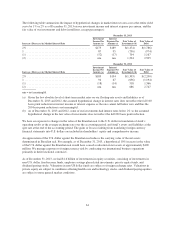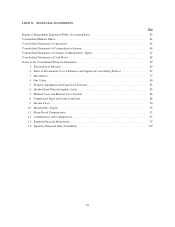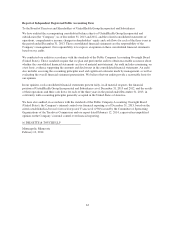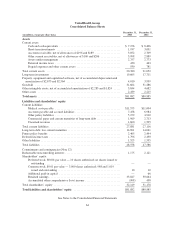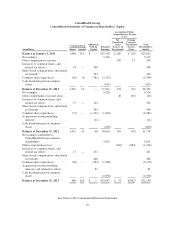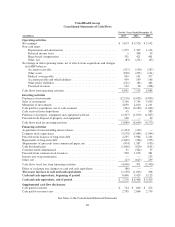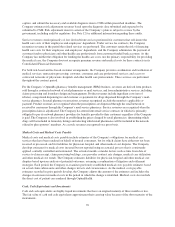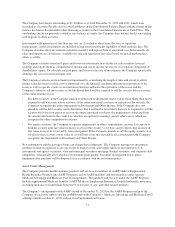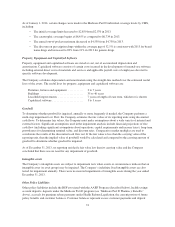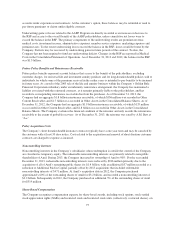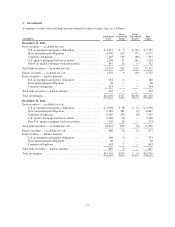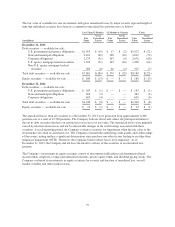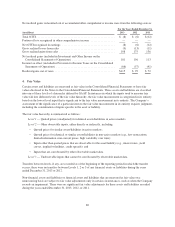United Healthcare 2013 Annual Report Download - page 73
Download and view the complete annual report
Please find page 73 of the 2013 United Healthcare annual report below. You can navigate through the pages in the report by either clicking on the pages listed below, or by using the keyword search tool below to find specific information within the annual report.The Company had checks outstanding of $1.3 billion as of both December 31, 2013 and 2012, which were
classified as Accounts Payable and Accrued Liabilities in the Consolidated Balance Sheets and the change in this
balance has been reflected within other financing activities in the Consolidated Statements of Cash Flows. The
outstanding checks are primarily related to zero balance accounts; the Company does not net checks outstanding
with deposits in other accounts.
Investments with maturities of less than one year are classified as short-term. Because of regulatory
requirements, certain investments are included in long-term investments regardless of their maturity date. The
Company classifies these investments as held-to-maturity and reports them at amortized cost. Substantially all
other investments are classified as available-for-sale and reported at fair value based on quoted market prices,
where available.
The Company excludes unrealized gains and losses on investments in available-for-sale securities from net
earnings and reports them as comprehensive income and, net of income tax effects, as a separate component of
shareholders’ equity. To calculate realized gains and losses on the sale of investments, the Company specifically
identifies the cost of each investment sold.
The Company evaluates an investment for impairment by considering the length of time and extent to which
market value has been less than cost or amortized cost, the financial condition and near-term prospects of the
issuer as well as specific events or circumstances that may influence the operations of the issuer and the
Company’s intent to sell the security or the likelihood that it will be required to sell the security before recovery
of the entire amortized cost.
• For debt securities, if the Company intends to either sell or determines that it will be more likely than not be
required to sell a security before recovery of the entire amortized cost basis or maturity of the security, the
Company recognizes the entire impairment in Investment and Other Income. If the Company does not
intend to sell the debt security and it determines that it will not be more likely than not be required to sell the
security but it does not expect to recover the entire amortized cost basis, the impairment is bifurcated into
the amount attributed to the credit loss, which is recognized in earnings, and all other causes, which are
recognized in other comprehensive income.
• For equity securities, the Company recognizes impairments in other comprehensive income if it expects to
hold the security until fair value increases to at least the security’s cost basis and it expects that increase in
fair value to occur in a reasonably forecasted period. If the Company intends to sell the equity security or if
it believes that recovery of fair value to cost will not occur in a reasonably forecasted period, the Company
recognizes the impairment in Investment and Other Income.
New information and the passage of time can change these judgments. The Company manages its investment
portfolio to limit its exposure to any one issuer or market sector, and largely limits its investments to U.S.
government and agency securities; state and municipal securities; mortgage-backed securities; and corporate debt
obligations, substantially all of which are investment grade quality. Securities downgraded below policy
minimums after purchase will be disposed of in accordance with the investment policy.
Assets Under Management
The Company provides health insurance products and services to members of AARP under a Supplemental
Health Insurance Program (the AARP Program), and to AARP members and non-members under separate
Medicare Advantage and Medicare Part D arrangements. The products and services under the AARP Program
include supplemental Medicare benefits (AARP Medicare Supplement Insurance), hospital indemnity insurance,
including insurance for individuals between 50 to 64 years of age, and other related products.
The Company’s arrangements with AARP extend to December 31, 2020 for the AARP Program and give the
Company an exclusive right to use the AARP brand on the Company’s Medicare Advantage and Medicare Part D
offerings until December 31, 2020, subject to certain limited exclusions.
71


